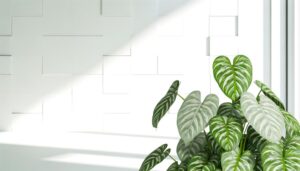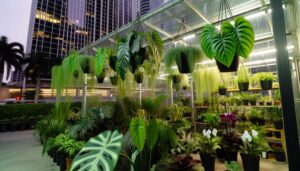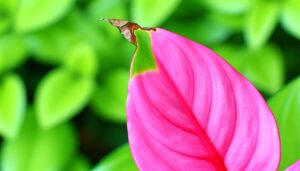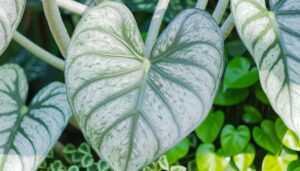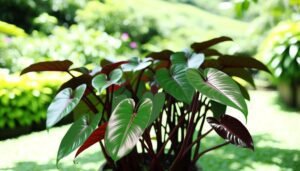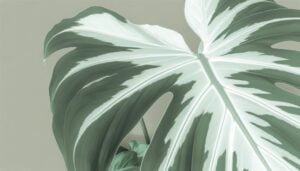What Is a Medium-Sized Philodendron Selloum?
A medium-sized Philodendron selloum, scientifically identified as Philodendron bipinnatifidum, showcases deeply lobed, dark green leaves that stretch between 30 to 60 centimeters. This plant typically grows to a stem height of 50 to 100 centimeters and an overall height of 1 to 1.5 meters.
It has a semi-woody stem structure and thrives in indirect sunlight, warm temperatures, and high humidity. Peak growth occurs in well-drained, fertile soil with consistent moisture, an acidic to neutral pH range, and the inclusion of pine bark to enhance nutrient exchange.
To explore the plant's detailed propagation methods and benefits, additional information is available.
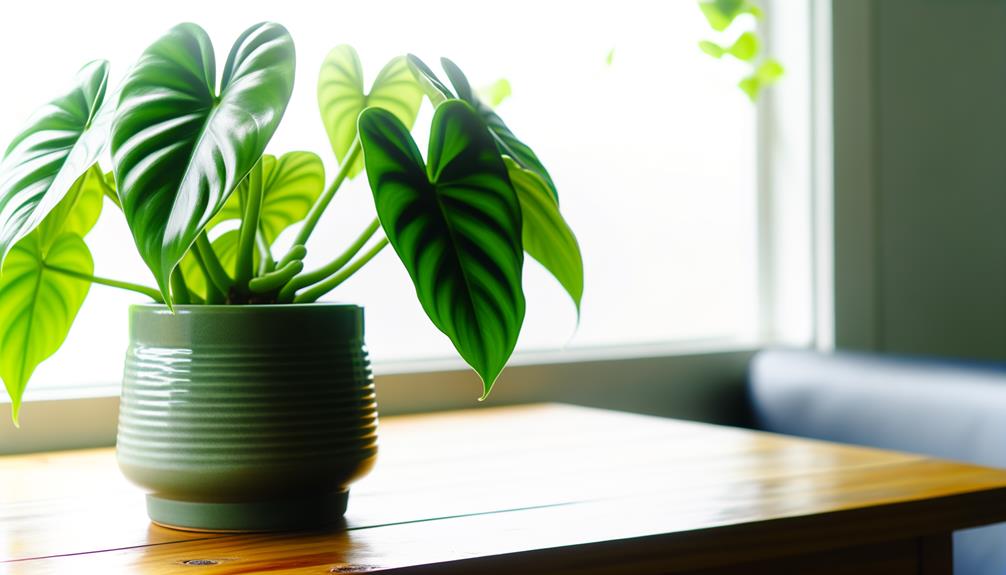
Key Takeaways
- Medium-sized Philodendron Selloum has deeply lobed, dark green leaves spanning 30-60 cm.
- Its semi-woody stem grows to heights of 50-100 cm.
- The plant thrives in indirect sunlight, high humidity, and well-draining, organic-rich soil.
- Common pests include aphids, spider mites, and mealybugs, which require effective management.
- Benefits include air quality improvement, humidity regulation, and enhancing psychological well-being.
Defining Medium-Sized
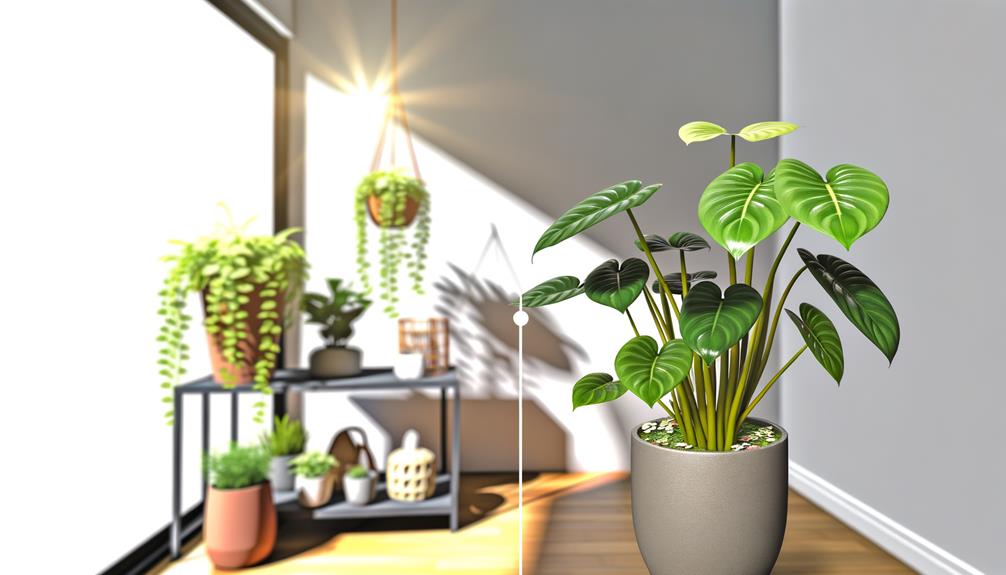
When categorizing Philodendron selloum as medium-sized, it is important to take into account specific metrics such as leaf span, stem height, and overall plant dimensions.
Typically, a medium-sized Philodendron selloum exhibits a leaf span ranging from 30 to 60 centimeters. The stem height generally falls between 50 to 100 centimeters, contributing to the overall stature of the plant.
The total plant dimensions, including the spread of the leaves and the height of the stems, often measure between 1 to 1.5 meters. These metrics serve as a guideline to differentiate medium-sized specimens from their larger and smaller counterparts.
Understanding these dimensions is pivotal for horticulturists and enthusiasts when selecting appropriate spaces and care regimens for this species.
Key Characteristics
Philodendron bipinnatifidum, commonly referred to as Philodendron Selloum, exhibits distinctive leaf morphology characterized by deeply lobed, dark green leaves.
The plant's growth habit includes a semi-woody stem structure that supports its expansive foliage, enabling it to reach moderate heights typical of medium-sized specimens.
These key characteristics contribute to its popularity in both indoor and outdoor horticultural settings.
Leaf Structure
The leaf structure of Philodendron selloum is a distinctive feature that contributes to its aesthetic and functional appeal.
Characterized by its deeply lobed, pinnatifid leaves that can reach up to 1.5 meters in length, these leaves are dark green, glossy, and exhibit a leathery texture, providing durability and resilience.
The lobes, which can number between 10 to 20, are irregularly shaped and deeply incised, creating a dramatic, tropical appearance.
The petioles are robust, supporting the substantial leaf blades and providing structural integrity.
The venation pattern is prominent, with a central midrib and lateral veins that extend towards the margins, enhancing the leaf's architectural beauty and facilitating efficient nutrient transport.
Growth Habit
Exhibiting a clumping growth habit, Philodendron selloum develops a robust, self-supporting trunk that enables it to reach heights of up to 3 meters, making it a striking specimen in both indoor and outdoor landscapes.
The growth is characterized by its expansive, spreading leaves that emerge from a central stem, contributing to a dense, bush-like appearance. This arborescent perennial plant demonstrates a slow to moderate growth rate, thriving in well-drained, fertile soil with consistent moisture.
Philodendron selloum's aerial roots, which develop along the stem, enhance its stability and nutrient absorption. Its ability to adapt to varying light conditions, from partial shade to bright indirect light, makes it a versatile addition to diverse horticultural settings.
Ideal Growing Conditions
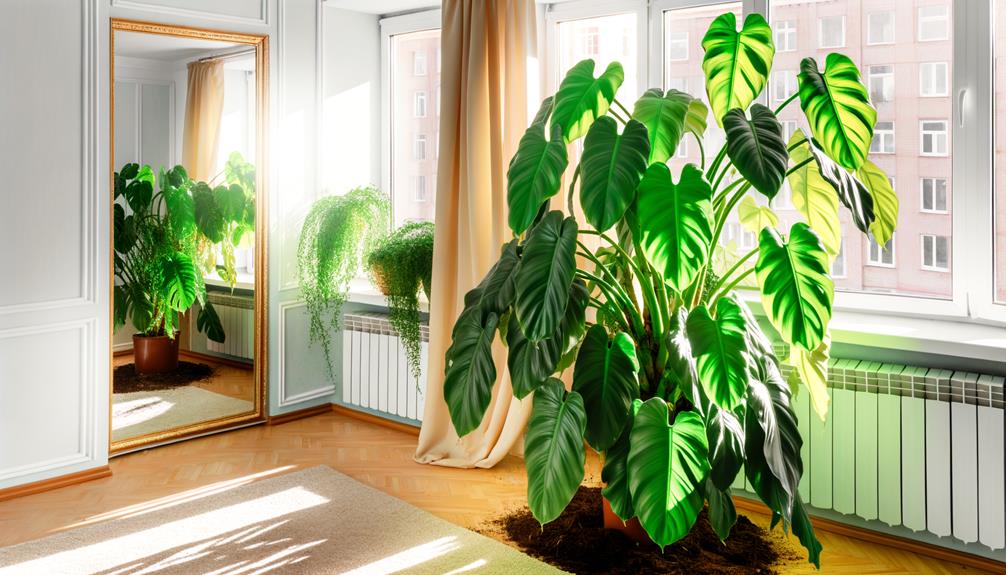
To achieve peak growth, Philodendron selloum requires a balance of indirect sunlight, warm temperatures, and high humidity levels. Best temperature ranges between 18°C to 24°C (64°F to 75°F), ensuring the plant thrives without exposure to cold drafts.
The species flourishes in humidity levels exceeding 60%, necessitating occasional misting or the use of a humidifier in drier climates.
Soil composition should consist of well-draining, organic-rich substrates, such as a mix of peat, perlite, and pine bark, to facilitate aeration and prevent root rot.
Regular watering is essential but should be moderated to avoid waterlogging, ideally allowing the top inch of soil to dry out between waterings.
Proper fertilization with a balanced, water-soluble fertilizer every month during the growing season further enhances robust development.
Light Requirements
Philodendron selloum thrives under bright, indirect light, which mimics the dappled sunlight of its native tropical understory habitat. This species, also known as Philodendron bipinnatifidum, requires approximately 6-8 hours of such light daily to maintain peak growth and vibrant foliage.
Direct sunlight may cause leaf burn, characterized by brown, crispy edges. Conversely, low light conditions can result in leggy growth and diminished leaf size. Utilizing sheer curtains or positioning the plant near east or north-facing windows can provide the ideal light intensity.
Artificial grow lights, specifically full-spectrum LED or fluorescent bulbs, can supplement natural light, especially in less luminous environments. Regularly rotating the plant ensures uniform light exposure, promoting symmetrical growth and robust development.
Watering Needs
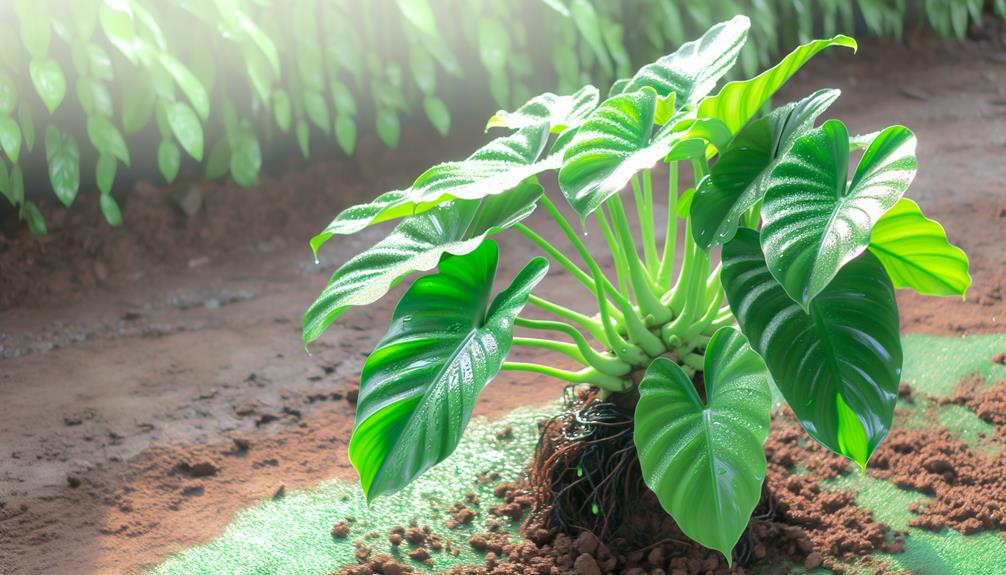
Philodendron bipinnatifidum, commonly known as Philodendron Selloum, requires a consistently moist but well-draining soil medium to thrive. Best moisture levels are achieved by watering when the top inch of soil feels dry, typically necessitating watering every 7-10 days.
Signs of overwatering include yellowing leaves and root rot, which can severely impact plant health.
Optimal Moisture Levels
Maintaining best moisture levels for Philodendron selloum, also known as Thaumatophyllum bipinnatifidum, is essential for its health, requiring consistent but moderate watering to keep the soil evenly moist. Striking the right balance is critical, as overwatering can lead to root rot while underwatering may cause leaf browning and wilting.
Key factors to take into account include:
- Soil Type: Utilize well-draining potting mix, often a blend of peat, perlite, and pine bark, to prevent waterlogging.
- Humidity: Maintain ambient humidity levels between 60-80% to mimic the plant's tropical origin.
- Drainage: Ensure pots have sufficient drainage holes to facilitate excess water escape, preventing root suffocation.
Frequency of Watering
To maintain peak moisture levels for Thaumatophyllum bipinnatifidum, understanding the frequency of watering is essential, as it guarantees the plant receives just the right amount of hydration without risking root damage.
This medium-sized philodendron thrives when its soil is consistently kept moist but not waterlogged. Typically, watering once a week is sufficient under average indoor conditions. However, adjustments may be necessary depending on environmental factors such as humidity, temperature, and light exposure.
It's advisable to allow the top inch of soil to dry out between waterings to prevent oversaturation. Employing a well-draining potting mix can further ensure ideal moisture retention and aeration, thereby fostering robust root health and vigorous growth for Thaumatophyllum bipinnatifidum.
Signs of Overwatering
Excessive watering of Thaumatophyllum bipinnatifidum can lead to a series of detrimental symptoms that indicate root distress and potential plant decline. Overwatering disrupts the oxygen supply to the roots, causing them to suffocate and potentially rot. Recognizing these signs early is important for maintaining plant health.
Key indicators include:
- Yellowing Leaves: Chlorosis occurs as waterlogged roots fail to uptake essential nutrients.
- Wilting Despite Moist Soil: Paradoxically, the plant may appear wilted even when the soil remains excessively wet.
- Root Rot: Fungal infections thrive in saturated conditions, leading to decayed, mushy roots.
Understanding these symptoms helps horticulturists and enthusiasts alike to adjust watering practices appropriately, ensuring the health of their Thaumatophyllum bipinnatifidum.
Soil Preferences
Philodendron selloum flourishes in well-draining soil rich in organic matter. Ideally, a blend of peat, perlite, and pine bark supports the best root health and growth. Peat offers essential moisture retention without waterlogging. Perlite improves aeration, preventing compacted soil conditions. Pine bark adds structural strength and assists in nutrient exchange, creating an optimal setting for root development.
Moreover, a slightly acidic to neutral pH range of 5.5 to 7.0 is preferred, enhancing nutrient availability and absorption. This combination of elements guarantees that the soil maintains adequate moisture levels while promoting proper drainage, essential for averting root rot.
Regular evaluation of soil composition and structure is advised to sustain the ideal growing conditions for Philodendron selloum.
Common Pests
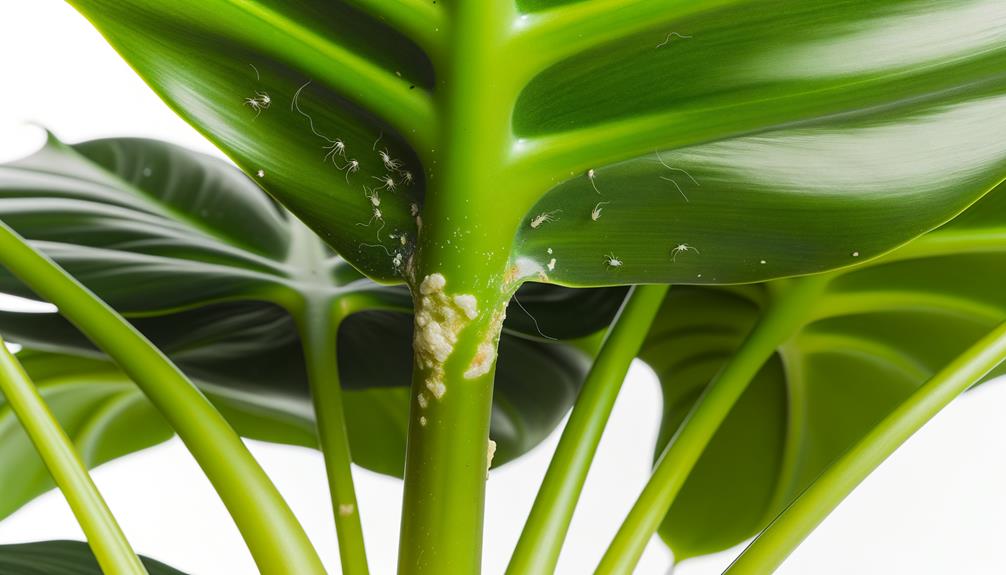
Frequently encountered pests that can affect Philodendron selloum include aphids (Aphididae), spider mites (Tetranychidae), and mealybugs (Pseudococcidae). These pests can impair plant health, causing symptoms ranging from stunted growth to leaf discoloration and deformation.
- Aphids (Aphididae): Small, sap-sucking insects that can cause yellowing and curling of leaves. They often excrete honeydew, leading to sooty mold growth.
- Spider Mites (Tetranychidae): Microscopic arachnids that feed on plant juices, resulting in fine webbing and speckled, discolored foliage.
- Mealybugs (Pseudococcidae): Soft-bodied insects covered in a white, waxy substance, which can lead to leaf drop and hindered growth by feeding on plant sap.
Effective pest management practices are essential in maintaining the health of Philodendron selloum.
Propagation Methods
Maintaining ideal plant health also involves understanding effective propagation methods for Philodendron selloum. These methods include stem cuttings, air layering, and seed germination. Stem cuttings involve excising a healthy stem segment with at least one node and placing it in a suitable rooting medium.
Air layering requires wounding a section of the stem, applying rooting hormone, and wrapping it with moist sphagnum moss. This is followed by a plastic covering to retain moisture. Seed germination, although less common, involves sowing seeds in a sterile, well-draining substrate under controlled humidity and temperature conditions.
Each method has specific requirements. Adherence to these guarantees successful propagation, thereby enhancing the plant's overall importance and sustainability within a controlled environment.
Benefits for Your Home
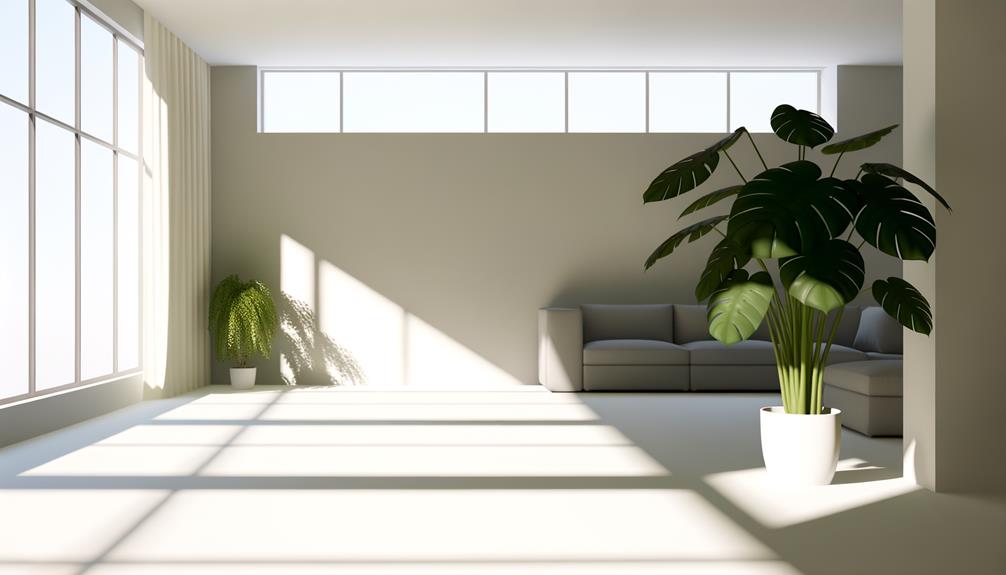
Integrating Philodendron selloum into your home interior not only enhances aesthetic appeal but also contributes to air purification and humidity regulation. Philodendron selloum, also known as Thaumatophyllum bipinnatifidum, is celebrated for its large, deeply lobed leaves which provide a lush, tropical ambiance.
Its functional benefits include:
- Air Quality Improvement: The plant absorbs airborne toxins such as formaldehyde and benzene, enhancing indoor air quality.
- Humidity Regulation: Through a process called transpiration, it releases moisture into the air, which can alleviate dry air conditions.
- Psychological Well-being: The presence of greenery has been shown to reduce stress levels and improve overall mental health.
This versatile species is a valuable addition to any interior space, offering both aesthetic and health benefits.
Conclusion
In summary, the medium-sized Philodendron selloum, characterized by its robust, deeply lobed leaves and manageable growth, offers an unparalleled blend of aesthetic appeal and ecological benefits.
Flourishing under ideal conditions of indirect sunlight, well-draining soil, and consistent hydration, this botanical marvel exemplifies resilience and adaptability.
Its propagation ease and minimal pest susceptibility further underscore its superiority as a houseplant.
Incorporating Philodendron selloum into indoor environments undeniably enriches air quality and enhances ornamental value, epitomizing the essence of indoor horticultural excellence.

